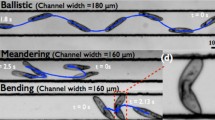Abstract
Paramecium or other ciliates have the potential to be utilized for minimally invasive surgery systems, making internal body organs accessible. Paramecium shows interesting responses to changes in the concentration of specific ions such as K+, Mg2+, and Ca2+ in the ambient fluid. Some specific responses are observed as, changes in beat pattern of cilia and swimming toward or apart from the ion source. Therefore developing a model for chemotactic motility of small organisms is necessary in order to control the directional movements of these microorganisms before testing them. In this article, we have developed a numerical model, investigating the effects of Ca2+ on swimming trajectory of Paramecium. Results for Ca2+-dependent chemotactic motility show that calcium gradients are efficient actuators for controlling the Paramecium swimming trajectory. After applying a very low Ca2+ gradient, a directional chemotaxis of swimming Paramecium is observable in this model. As a result, chemotaxis is shown to be an efficient method for controlling the propulsion of these small organisms.













Similar content being viewed by others
References
Cooper, M. S. (2008). Diagnosis and management of hypocalcaemia. BMJ, 336(7656), 1298–1302.
Kassim, I., Phee, L., Gong, F., Dario, P., & Mosse, C. A. (2006). Locomotion techniques for robotic colonoscopy. IEEE Engineering in Medicine and Biology Magazine, 25(3), 49–56.
Freitas, R. A. (2005). Nanotechnology, nanomedicine and nanosurgery. International Journal of Surgery, 3(4), 243–246.
Dogangil, G., Ergeneman, O., Abbott, J. J., Pan´e, S., Hall, H., et al. (2008). Toward targeted retinal drug deliverywith wireless magnetic microrobots. In Proceedings IEEE/RSJ international conference intelligent robots system. 22–26 September, 1921–1926
Haga, Y., & Esashi, M. (2004). Biomedical microsystems for minimally invasive diagnosis and treatment. Proceedings of the IEEE, 92(1), 98–114.
Saliterman, S. S., (2006). Fundamentals of BioMEMS and Medical Micro devices. Bellingham, WA: SPIE. ISBN 0-8194-5977-1.
Fearing, R. S., (1991). Control of a micro-organism as a prototype micro robot. In 2nd International symposium on micromachines ans human sciences. Nagoya, japan.
Fukui, K., & Asai, H. (1985). Negative geotactic behavior of Paramecium caudatum described by the mechanicm of buoyancy-oriented upward swimming. Biophysical Journal, 47, 479–482.
Ogawa, N., Oku, H., Hashimoto, K., Ishikawa, M., (2005). Dynamics model of Paramecium galvanotaxis for microrobotic application. In Proceedings of the 2005 IEEE international conference on robotics and automation, Barcelona, Spain, April 2005.
Oosawa, F. (2007). Spontaneous activity of living cells. Biosystems, 88, 191–201.
Hirano, A., Tsuji, T., Takiguchi, N., Ohtake, H. (2006) An electrophysiological model of chemotactic response in Paramecium. In IEEE conference on systems, man, and cybernetics 8–11 October, 2006, Taipei, Taiwan
Furukawa, S., & Kawano, T. (2012). Enhanced microsphere transport in capillary by conditioned cells of green Paramecia used as living micromachines controlled by electric stimuli. Sensors and Materials, 24(7), 275–386.
Giuffre, C., Hinow, P., Vogel, R., Ahmed, T., Stocker, R., Thomas, R., et al. (2011). The ciliate Paramecium shows higher motility in non-uniform chemical landscapes. Plos One, 6, E15274.
Nakaoka, Y., Tanaka, H., & Oosawa, F. (1984). Ca2+ dependent regulation of beat frequency of cilia in Paramecium. Journal of Cell Science, 65, 223–231.
Lansley, A. B., & Sanderson, M. J. (1999). Regulation of airway ciliary activity by Ca2+: Simultaneous measurement of beat frequency and intracellular Ca2+. Biophysical Journal, 77, 629–638.
Alvarez, L., Dai, L., Friedrich, B. M., Nachiket, D., Kashikar, I. G., Pascal, R., & Kaupp, U. B. (2012). The rate of change in Ca2+ concentration controls sperm chemotaxis. Journal of Cell Biology, 196(5), 653–663.
Dryl, S., & Kurdybacha, J. (1978). Dependence of chemotaxis in Paramecium caudatum and Paramecium tetraurelia 51 s on concentration of calcium ions in external medium. Acta Protozoologica, 174, 551–559.
Wang, S., & Ardekani, A. M. (2012). Unsteady swimming of small organisms. Journal of Fluid Mechanics, 702, 286–297.
Zhu, L., Do-quang, M., Lauga, E., & Brandt, L. (2011). Locomotion by tangential deformation in a polymeric fluid. Physical Review E, 83(1), 011901.
Blake, J. R. (1971). A spherical envelope approach to ciliary propulsion. Journal of Fluid Mechanics, 46, 199–208.
Olson, S. D. (2013). Fluid dynamic model of invertebrate sperm chemotactic motility with varying calcium inputs. Journal of Biomechanics, 46, 329–337.
Sochivco, D., Pereverzev, A., Smyth, N., Gissel, C., Schneider, T., & Beck, H. (2002). The Cav2.3 Ca2+ channel subunit contributes to R-type Ca2+ currents in murine hippocampal and neocortical neurons. Journal of Physiology, 542(3), 699–710.
Palagi, S., Jager, E. W., Mazzolai, B., & Beccai, L. (2013). Propulsion of swimming microrobots inspired by metachronal waves in ciliates: From biology to material specifications. Bioinspiration and Biomimetics, 8, 046004.
Author information
Authors and Affiliations
Corresponding authors
Rights and permissions
About this article
Cite this article
Sarvestani, A.N., Shamloo, A. & Ahmadian, M.T. Simulation of Paramecium Chemotaxis Exposed to Calcium Gradients. Cell Biochem Biophys 74, 241–252 (2016). https://doi.org/10.1007/s12013-016-0727-8
Received:
Accepted:
Published:
Issue Date:
DOI: https://doi.org/10.1007/s12013-016-0727-8




